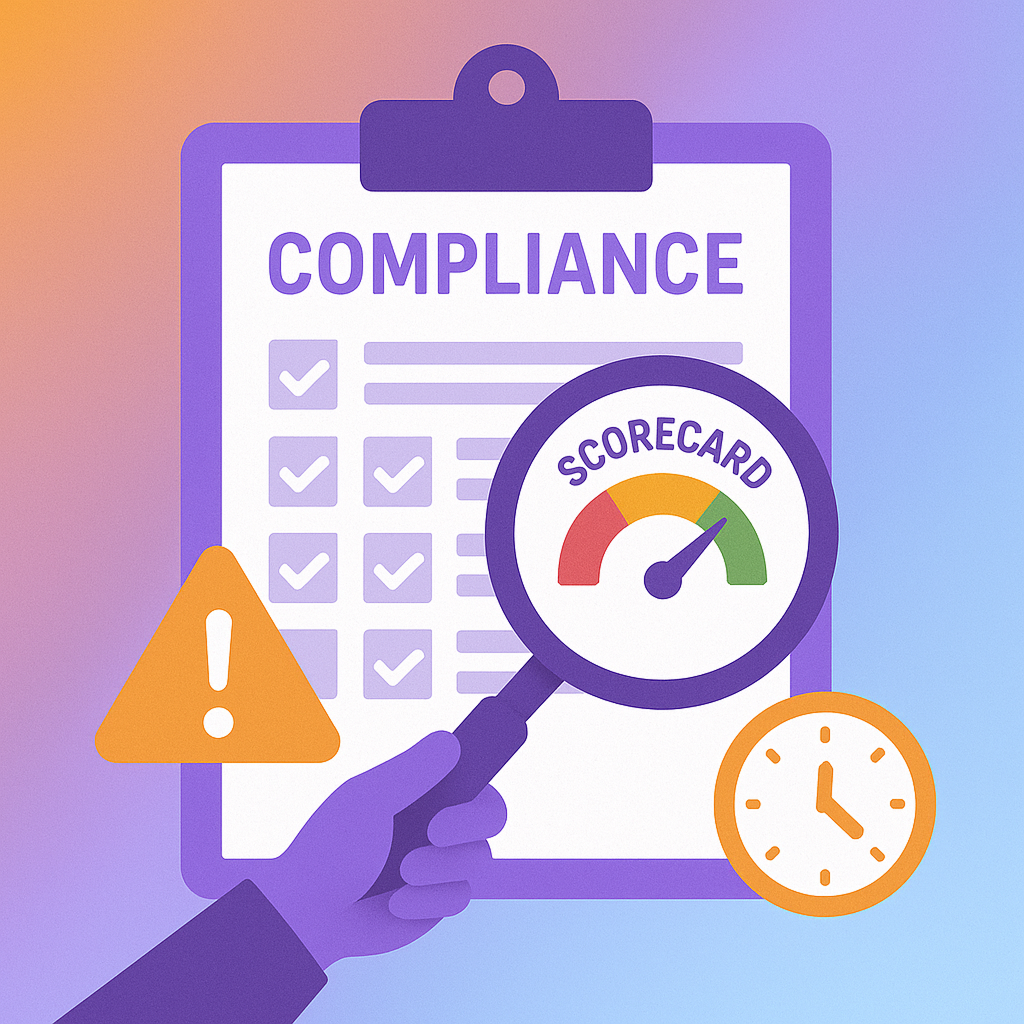
COI Compliance Scorecard: Where Does Your Process Stand?
For years, compliance has been treated like the cost of doing business. A checklist. A fire drill. A box to tick so projects could move forward.
But what if compliance could be something more?
Risk has always lived in the shadows — complex insurance language, hidden exclusions, endless workflows. That’s why compliance has often felt fear-based. Necessary, but never empowering.
With modern tools and AI, that’s changing. Compliance can move from hidden liability to growth driver. This scorecard helps you find where your process stands today, understand the risks of staying stuck, and map the path toward fearless growth.
The Four Stages of COI Management
Every company falls somewhere on this spectrum:
- At Risk (in the shadows)
- Reactive (fire drills)
- Proactive (organized but heavy)
- Optimized (compliance as growth)
Let’s break down what each stage looks like in real life.
Stage 1: At Risk (In the Shadows)
What it looks like:
- COIs scattered across spreadsheets, inboxes, or — yes — file cabinets.
- Expired or missing certificates slipping through unnoticed.
- No single source of truth.
How it feels:
- Teams living with that low-level hum of anxiety: “Did we miss something?”
- Projects stalling when someone realizes coverage isn’t documented.
- Audits looming like a storm cloud.
Business impact:
- Hidden liabilities that can explode into lawsuits.
- Leadership has zero visibility into compliance health.
- Compliance becomes the weak link that slows deals and creates doubt.
Friendly Insight: Even moving COIs into a shared drive with consistent naming beats inbox chaos. It’s not perfect, but it’s a step out of the shadows.
Stage 2: Reactive (Fire Drills)
What it looks like:
- Requests go out, but reminders are manual.
- Renewals sneak up, exceptions slip through.
- Every renewal season feels like survival mode.
How it feels:
- Admins spend entire weeks chasing vendors.
- Vendors get frustrated with rushed reminders.
- Leaders only hear about compliance when there’s a problem.
Business impact:
- Projects start late.
- Vendor relationships fray.
- Error rates climb when teams juggle too much.
Mini-Story: Imagine onboarding 40 vendors for a project. Half deliver COIs on time. The other half don’t. Your team spends two weeks in follow-up mode, delaying kickoff and straining relationships before the work even begins.
Stage 3: Proactive (Organized but Heavy)
What it looks like:
- Requests are consistent, requirements are clear.
- Spreadsheets or legacy tools track expirations.
- Exceptions are escalated systematically.
How it feels:
- More control, but crushing workload.
- Data entry consumes valuable hours.
- Renewal season still bottlenecks progress.
Business impact:
- Risk exposure drops, but efficiency stalls.
- Compliance seen as a “necessary burden,” not a partner.
- Staff burnout rises as admins cycle out.
Friendly Insight: Right-size requirements. A landscaper doesn’t need the same coverage as a steel erector. Tiering vendors by risk saves time and builds trust.
Stage 4: Optimized (Compliance as Growth)
What it looks like:
- COI collection, reminders, and exceptions are automated.
- Smart dashboards show compliance status at a glance.
- Endorsements verified automatically, audit trails built behind the scenes.
- Compliance data flows into leadership dashboards.
How it feels:
- Admins stop firefighting and start advising.
- Vendors experience a smoother, more professional onboarding.
- Leaders trust compliance because visibility is instant.
Business impact:
- Projects start faster.
- Vendor trust deepens.
- Disputes and claims drop dramatically.
- Compliance becomes part of the growth engine.
Mini-Story: One illumend client cut onboarding from weeks to days with automated requests. Instead of “the nagging team,” compliance became the group that cleared the runway for work to start.
Metrics That Matter
No matter where you fall on the scorecard, these metrics spotlight progress:
- Time to approve a COI → Faster approvals = quicker starts.
- Compliance rate by vendor tier → Pinpoints your biggest risks.
- Exceptions resolved per week → Measures process efficiency.
- Expirations caught before lapse → Critical for avoiding gaps.
- Audit readiness → How quickly you can produce documentation.
Friendly Insight: Even tracking two of these consistently can give you leverage with leadership — and proof that compliance drives outcomes, not just paperwork.
From Fear to Fearless Growth
For too long, compliance has been fear-driven: confusing language, hidden risks, endless manual loops. That system is broken.
illumend exists to turn friction, fear, and complexity into trust and confidence. With AI-native compliance, what used to be a liability becomes a lever for growth.
Because compliance isn’t a cost center anymore. It’s progress. It’s protection. It’s part of your growth story.
📥 Next Step: Download the COI Compliance Scorecard — your interactive tool to map your process, identify risks, and uncover opportunities for fearless growth.
Or keep exploring: Read: Top 5 COI Mishaps That Cost Businesses Time, Money, and Trust — and see the most common pitfalls hiding in COIs.
